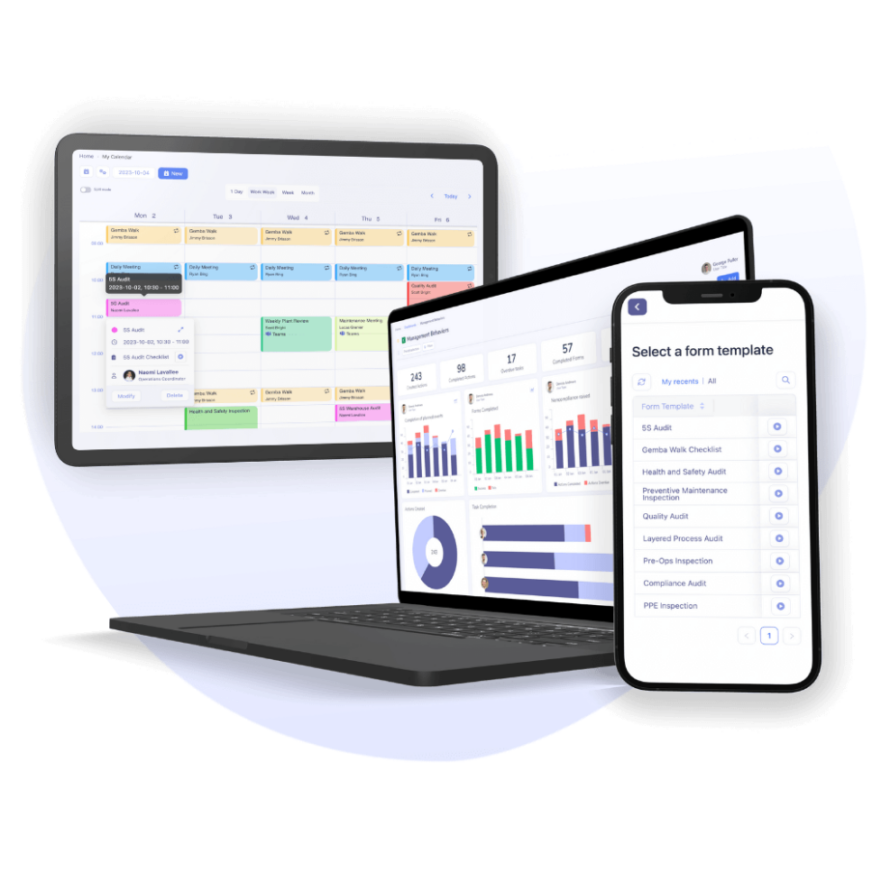Tips for Running Effective Daily Huddles and Daily Production Meetings for Manufacturers

| Audience: | Manufacturing Managers, Healthcare Administrators, Operational Excellence and Lean Management Practitioners, HR Coordinators, Organizational Leaders |
| Last updated: | August 2, 2025 |
| Read time: | 10 min |
- Break meetings down by management level (Tier 1, 2, 3) to keep conversations relevant and decisions efficient.
- Keep meetings short, stick to an agenda, start with good news, and wrap up with clear action items.
- Standardize meeting times across daily and weekly calendars to boost accountability, consistency, and focus.
In factories, daily production meetings and huddles are essential for maintaining a smooth workflow, keeping team members informed about progress, and addressing any issues that may arise. However, these meetings can quickly become ineffective if they are not structured properly.
Before we dive into how to run great meetings, let’s get clear on what each type is and why they’re not the same.

What’s the difference between a daily huddle time and a production meeting?
Daily huddles and production meetings might sound similar, but they serve different purposes on the shop floor. Knowing the difference helps you run both more effectively.
Quick definitions and goals:
- Daily huddle is a short, focused meeting that keeps everyone aligned and energized. The goal is to share key updates, spot problems early, and keep momentum going.
- Production meeting is a bit longer and more detailed. It dives into actual production data, performance, issues, and action plans. The goal here is to solve problems and make decisions that keep operations on track.
So what does this actually look like day-to-day? Here’s a quick breakdown to help you see the key differences at a glance:
| Item | Daily huddle | Production meeting |
| Timing | Start of each shift/day | Once daily or a few times a week |
| Duration | 5–15 minutes | 20–30 minutes |
| Attendees | Operators, leads, supervisors | Managers, planners, quality, maintenance leads |
| Focus | Alignment, quick updates, energy | Deeper dive into data, solving problems |
| Tone | Fast, casual, energizing | Focused, data-driven |
| Outcome | Team clarity and motivation | Decisions, accountability, improvement actions |
Knowing when to use each type of meeting (and who to include) helps you avoid confusion, keep things moving, and get better results.
What is an example of a weekly meeting schedule?
| Monday | 8:30 AM | Daily Huddle – Production Team |
| Monday | 10:00 AM | Weekly Production Meeting – Production Team Leaders |
| Tuesday | 8:30 AM | Daily Huddle – Quality Team |
| Tuesday | 9:00 AM | Daily Huddle – Maintenance Team |
| Wednesday | 8:30 AM | Daily Huddle – Production Team |
| Wednesday | 9:00 AM | Daily Huddle – Safety Team |
| Thursday | 10:00 AM | Weekly Production Meeting – Production Team Leaders |
| Friday | 8:30 AM | Daily Huddle – Production Team |
Now that you know the difference, let’s talk about structure. Tiered meetings help you get the right people focused on the right things, at the right level.
Why should you separate meetings by tier (daily huddle format)?
If your meetings feel crowded, confusing, or too long, it might be time to “tier” them. Tiered meetings are a simple structure that keeps the right people focused on the right things at the right time.
Tier 1 meetings typically involve front-line supervisors and focus on day-to-day operations and problem-solving. Tier 2 meetings involve middle managers and focus on longer-term planning and strategy. Tier 3 meetings involve senior executives and focus on high-level strategic and careful planning and decision-making.
Here’s how it works:
| Tier | Who attends | How often | Focus areas |
| Tier 1 | Operators, team leads, shift supervisors | Daily (start of shift) | Safety, today’s plan, issues, quick wins |
| Tier 2 | Supervisors, maintenance, quality, planners | Daily or a few times/week | Escalations, production issues, cross-team alignment |
| Tier 3 | Plant managers, ops leaders, department heads | Weekly or bi-weekly | Metrics, staffing, strategy, big-picture decision-making |
Each tier filters information up or down. This keeps frontline teams from getting bogged down in topics they can’t solve. It also protects senior leaders from daily distractions they don’t need to handle.
Tiered meetings also speed up decision-making. Issues get escalated fast, and important decisions get made at the right level without bottlenecks. No more wasted time or “too many people in the room” syndrome.
Once you’ve got the right people in the room, timing matters. Keep it short and sharp so it doesn’t slow down the work.
How long should these meetings be?
Consistent time on the shop floor is valuable. Every minute counts. That’s why keeping your meetings short and focused is key to making them effective.
Here’s a quick guide to ideal meeting lengths:
- Daily huddles (Tier 1) are 10–15 minutes max. Just enough to check in, share updates, and flag any issues. Standing meetings help keep things moving.
- Production meetings (Tier 2) run 20–30 minutes. These meetings need more detail but shouldn’t drag. Stick to the data, the problems, and the action plans.
- Leadership meetings (Tier 3) last 30–45 minutes. These might run a little longer but should still stay tight. The goal is high-level decisions, not a play-by-play.
Short meetings keep people engaged. When your team knows it’ll only take 10 or 15 minutes, they’re more likely to stay focused and speak up. No one tunes out because they’re watching the clock.
It also means less time away from actual work. You’re not pulling folks off the floor for an hour: they check in, get aligned, and get moving. That shows you respect their time and their role.
Shorter meetings lead to faster problem-solving too. When there’s less time, people get straight to the point. They skip the side stories and focus on what actually matters.
And finally, short meetings fit easily into the daily rhythm. You don’t have to rearrange schedules or delay production. It becomes a habit: quick, useful, and part of the flow.
Long meetings often lead to side conversations, rabbit holes, or repetition. When you keep things short, people are more likely to stay sharp and speak up.
A few best practices to stay on time:
- Start and end on time, every time.
- Use a visual agenda or board everyone can see.
- Assign a timekeeper or facilitator to keep things moving.
- Save long discussions for follow-ups, not the group.
Being respectful of people’s time shows you value their hard work. And when meetings are short, clear, and useful, your team will actually want to show up.
A tight agenda keeps your meeting on track. Here’s how to build one that’s easy to follow and actually useful.

How do you set a simple, clear agenda for your construction daily huddle?
If you want your meetings to run smoothly, start with a solid agenda. It keeps everyone on track, focused, and ready to contribute. And the good news? It doesn’t have to be complicated.
Here are the key components of a strong daily meeting agenda:
- A quick look back at yesterday
- Today’s plan and top priorities
- Key numbers (like safety, quality, or downtime)
- Issues or roadblocks
- Team shout-outs or quick announcements
To make it even easier, use a simple 5-point format like this:
| Agenda point | What to cover |
| 1. Safety check | Any risks, incidents, or near-misses? |
| 2. Yesterday’s recap | Did we hit our numbers? Any problems? |
| 3. Today’s plan | What’s the goal? Staffing or schedule changes? |
| 4. Issues to flag | Equipment, materials, process and safety concerns? |
| 5. Shoutouts + news | Recognize wins, share updates, end on a positive note |
This agenda works great for Tier 1 huddles, and you can build on it for higher-level meetings by adding metrics or deeper analysis.
Why consistency matters? When you follow the same structure every day, people know what to expect. This consistency saves time and reduces confusion. Consistent time also helps new team members catch on quickly.
Plus, when your team sees that meetings are organized and predictable, they’ll show up more prepared and more engaged with deeper understanding of everything.
You’ve got the agenda and agenda items, but what about engagement? Let’s talk about how to get your team talking, not tuning out.
How do you get the team to actually participate?
Ever feel like you’re the only one talking in a meeting? You’re not alone. But with a few simple strategies, you can turn your morning huddles into real two-way conversations.
First, make it easy for people to speak up.
Try a quick round-robin: go around the group and let each person share one thing. It could be a win, a concern, or a heads-up. This gives everyone a voice without putting them on the spot.
Another great tactic: rotate who leads the meeting.
Let team members take turns running the huddle process. It builds confidence, ownership, and variety. People are more likely to speak when they’ve had a turn in the driver’s seat.
Always make space for feedback – it’s the purpose of daily huddles.
At the end of the meeting, ask a simple question like, “Anything we’re missing?” or “Any concerns before we hit the floor?” Pause. Let the silence work. It gives people time to think.
And here’s the big one: psychological safety.
That just means people feel safe to speak up without fear of being ignored, laughed at, or blamed. You can build that approach by:
- Listening without interrupting
- Thanking people for speaking up, even if you disagree
- Following up when someone raises an issue
When people feel respected and heard, they’ll contribute more. And when they see their input leads to action, they’ll keep showing up with ideas.
So if you want your meetings to work, don’t just talk at your team, talk with them.
Before everyone heads back to work, make sure there’s clarity. Here’s how to wrap things up with purpose and action.
How do you end meetings with impact (team huddles ideas)?
How you end a meeting matters just as much as how you start it. If everyone walks away unsure of what’s next, you’ve just had a conversation, not a productive meeting. The goal is to leave with clarity and momentum.
Start by locking in action items.
Before wrapping up, quickly review what needs to get done. These should be clear, simple, and doable. Don’t let tasks get buried in vague promises like “we’ll look into it.”
Then, assign ownership, loud and clear.
Every action item should have one owner. Not a group. Not “the team.” Pick a name. When people know exactly what they’re responsible for, things get done faster. You can say things like:
- “Can you take the lead on that?”
- “Let’s have Sarah own that and update us tomorrow.”
Don’t forget to follow up.
Start each meeting by checking on open agenda items from the day before. Keep it light and positive. Just a quick “What’s the status?” This creates a feedback loop and shows the team that action items matter.
When participants see real follow-through, they start bringing better input. Why? Because they know something actually happens after they speak up.
To sum it up:
- Wrap with clear next steps
- Assign a name to each action
- Follow up the next day
It’s a simple habit, but it turns meetings into results. And that’s the real win.
Managing meetings manually works, but digital tools can make it smoother, faster, and more reliable. Let’s look at how.
How can digital tools help manage all of this?
Running effective daily huddles and production meetings consistently can get tricky, especially as teams grow and shift. That’s where digital tools come in. They help you stay organized, follow up faster, and make your meetings actually work.
Here’s why a daily management system makes a difference:
- Keeps agendas and notes in one place
- Tracks action items automatically
- Makes it easy to follow up on past issues
- Gives visibility across teams and shifts
You don’t have to rely on sticky notes, whiteboards, or someone’s memory. A digital system brings structure without adding work.
Tervene is one example of a tool built for this.
It’s designed specifically for manufacturers running tiered meetings and daily tasks. With Tervene, you can:
- Standardize your meeting agendas
- Log issues, assign owners, and track progress
- Share updates across shifts and departments
- Monitor key KPIs in real time
Everything’s in one place. No more chasing spreadsheets or trying to remember what was said yesterday.
Digital tools also drive accountability and improvement.
When tasks are assigned, tracked, and visible, things don’t fall through the cracks. Leaders follow up. Teams follow through. And improvement becomes part of the daily routine.
You don’t need tech to run great meetings, but it sure helps. The right tool like Tervene supports your process, not replaces it.
Tervene, Daily Management System
Tervene is the best all-in-one solution to support your operational control, leader standard work, continuous improvement, and QEHS processes.

Frequently Asked Questions (FAQ) About Factory Production Meetings and Daily Huddles
A daily production meeting, often called a daily huddle, is a short, structured meeting held on the factory floor to review production goals, discuss challenges, share safety updates, and align teams for the day’s tasks.
Daily huddles keep teams aligned, improve communication, and allow for quick problem-solving. They help ensure that everyone is aware of production targets, safety issues, and operational priorities, reducing delays and inefficiencies.
Separating meetings by management levels ensures that discussions are relevant to participants’ responsibilities.
-
Tier 1: Front-line supervisors — daily operations and immediate issues
-
Tier 2: Middle management — tactical planning and coordination
-
Tier 3: Executives — strategic planning and long-term decision-making
Factory huddles should be concise, typically lasting 15 to 30 minutes. Keeping meetings short ensures minimal disruption to production while maximizing focus on key issues.
A clear agenda should cover:
-
Daily production targets and results
-
Safety updates or incidents
-
Priority tasks and resource allocation
-
Recognition of achievements
-
Action items and responsibilities
Create a collaborative environment by inviting team members to share updates, ask questions, and raise concerns. Rotating leadership roles or using visual aids can also help boost engagement.
Standardizing meeting times (daily and weekly) helps prevent confusion, promotes accountability, and ensures consistent attendance and preparation. It also makes it easier to monitor performance and track progress over time.
Gemba Walks involve supervisors visiting the production floor to observe processes and engage with employees. They complement daily huddles by identifying real-time issues and helping integrate insights into meeting discussions.



























